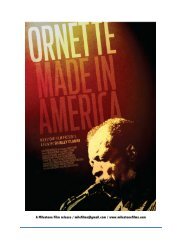Press Kit - Shirley Clarke
Press Kit - Shirley Clarke
Press Kit - Shirley Clarke
You also want an ePaper? Increase the reach of your titles
YUMPU automatically turns print PDFs into web optimized ePapers that Google loves.
Albert Brenner, Art Director<br />
(February 17, 1926 – present)<br />
Production designer Albert Brenner has served as production designer or art Director on 57 films through four <br />
decades, has received five Academy Award nominations and the Art Director’s Guild’s Lifetime Achievement <br />
Award. <br />
Brenner’s Oscar® nominations were for Beaches (1989), 2010:The Year We Make Contact (1984), California <br />
Suite (1978), The Turning Point (1977), and The Sunshine Boys (1975). He designed five films for Herbert Ross, <br />
(including The Goodbye Girl and I Ought to Be in Pictures), five films for Garry Marshall (Frankie & Johnny, <br />
Princess Diaries II, Georgia Rule and Pretty Woman) and worked with Sidney Lumet on Fail-Safe and The <br />
Morning After. He has also worked with Mel Brooks, Billy Crystal (for his directorial debut Mr. Saturday Night), <br />
Ron Howard and Robert Mulligan. <br />
Born in Brooklyn, Brenner served as an Air Force Gunner during World War II and attended Yale Drama School <br />
of Graduate Studies as a scenic design major. While designing for the stage, he also worked on live television for <br />
CBS and ABC. Albert segued into film working with (two-‐-‐-‐time Oscar winner) Richard Sylbert on The <br />
Connection and The Pawnbroker. Later, he worked with production designer Harry Horner on The Hustler, which <br />
won an Oscar® for Black-‐and-‐white Art Direction. Brenner’s work as a production designer has spanned the <br />
range of motion picture styles and genres. He also designed the New York Street set in the back lot of <br />
Paramount Studios. Now retired, he lives with his wife in California and devotes his time to painting. <br />
Richard Sylbert, Production Designer<br />
(April 16, 1928 – March 23, 2002)<br />
Richard Sylbert, trained by the famed William Cameron Menzies, became himself a legendary Academy Award® <br />
winning production designer and art director, known for such films as Baby Doll, A Face in the Crowd, Splendor <br />
in the Grass, The Manchurian Candidate, Who’s Afraid of Virginia Woolf?, Rosemary’s Baby, The Graduate, <br />
Chinatown, Reds, Dick Tracy, Mulholland Falls and dozens of other classic films. In 1975 Robert Evans chose <br />
Sylbert to replace him as head of production for Paramount. He oversaw several hits while there including <br />
Looking for Mr. Goodbar and The Bad News Bears but his penchant for art house fare such as Nashville and Days <br />
of Heaven and his lack of concern over failures (after all, he was still the best Art Director in town) led Barry <br />
Diller to fire him in 1978. From a family of Romanian immigrants, Richard Sylbert grew up in Brooklyn (he read <br />
on the roof of his building by the lights of Ebbets Field), studied painting at the Tyler School of Art and fought in <br />
the Korean War before entering television in 1953 with the Hallmark Hall of Fame’s production of Hamlet. His <br />
most seen work might have been in television with his production design of the bar in Cheers. He died from <br />
cancer at the age of 73. <br />
Jack Gelber<br />
(April 12, 1932 – May 9, 2003)<br />
Jack Gelber was born in Chicago to a Jewish couple of Romanian and Russian descent. While at the University of <br />
Illinois, he first developed an interest in writing fiction. He moved to New York City in the mid-‐1950s and <br />
worked as a mimeograph operator at the United Nations. He became friends with the jazz musicians and theatre <br />
artists and after marrying in 1957 and spending time in Haiti, he decided there to combine his two interests. <br />
From this, came his first play, which he described as “the seamier side, the underbelly of life.” When he came <br />
back to New York, the play was accepted by Julian Beck & Judith Malina of The Living Theatre where he got his <br />
first theatrical education. They allowed him to be involved in every aspect of the production: “The whole <br />
experience had a kind of magic quality to it. In my innocence, I wanted to know everything.” He was only 26 <br />
when his play “The Connection” initially shocked and appalled much of the theater world. (“A farrago of dirt” <br />
claimed the New York Times.) But championed by the critics Kenneth Tynan and Jerry Talmer, it soon became <br />
<br />
20




